High blood pressure (hypertension) is recognized as a leading cardiovascular risk factor. And, because it is usually symptomless at first, it is often referred to as the "silent killer." Here are some staggering facts and figures to help you better understand the negative effects of poor cardiovascular health.
- Hypertension occurs when arterioles — the small thin-walled branches of an artery — become stiff and inflexible. The increasing resistance to blood flow causes hypertension. High blood pressure in turn damages artery walls, making them more vulnerable to plaque buildup. It also weakens and enlarges the heart.
- A staggering 42 percent of Canadians with high blood pressure are unaware of its presence. About 23 percent of Canadians have been diagnosed with high blood pressure, but only 16 percent of those are both being treated and have their blood pressure under control.
- High blood pressure is responsible for most of the 50,000 strokes that Canadians suffer each year.
- The odds are 90 percent that you'll develop high blood pressure sooner or later — whether you're a man or a woman. While men under 55 are more likely than women to have high blood pressure, once women reach 55 they tend to catch up with, and even overtake, the men. The condition is less common in younger adults but more common in people of Afro-Caribbean origin and from the Indian sub-continent.
- Genetics may account for 30 percent of cases of hypertension. For the rest of us, it's a combination of higher-than-normal fluid content in the bloodstream (often due to an excessively salty diet) plus narrower, stiffer arteries — the result of atherosclerosis, inactivity, being overweight, living with chronic stress and/or diabetes.
- In a gruesome experiment in 1733, Stephen Hales, a British veterinarian and botanist, first demonstrated the force of blood pressure. He attached a thin brass tube to a horse's neck artery and measured the height the blood reached. According to his report, blood shot nine feet up the tube.
- In the intervening years, an Italian physician developed a non-invasive way to check human blood pressure — the sphygmomanometer, a version of which doctors still use today.
- The first low-salt diet — a menu of plain rice and fruit — became the first blood pressure-lowering health food diet in the mid-1940s.
- Drug companies devised the first successful class of hypertension drugs — diuretics — in the 1950s, and they are still first-line drugs on the market today.
Remember these hard truths about hypertension to help motivate you to take better care of your heart and increase your chances of preventing hypertension.









